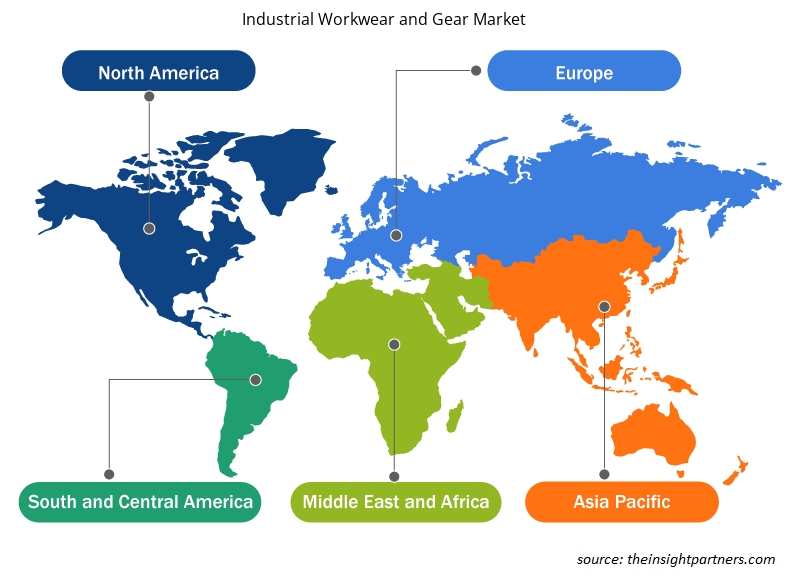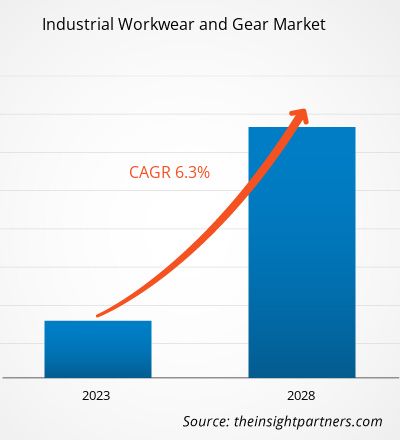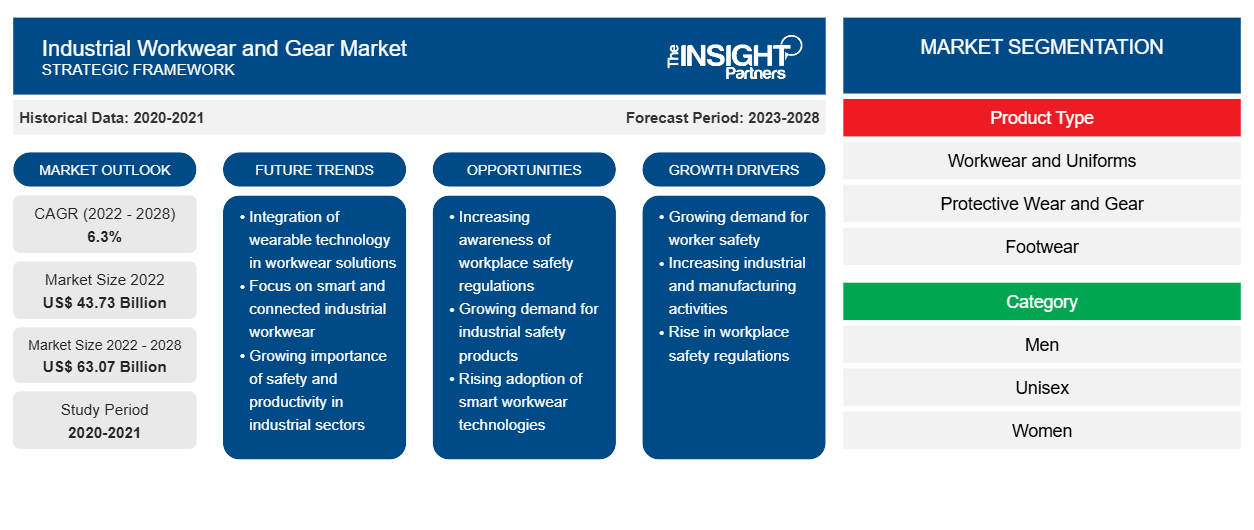La taille du marché des vêtements et équipements de travail industriels devrait passer de 43 725,45 millions USD en 2022 à 63 072,02 millions USD d'ici 2028 ; le marché devrait enregistrer un TCAC de 6,3 % de 2022 à 2028.
Les vêtements de travail industriels contribuent à assurer la sécurité des travailleurs dans les environnements industriels. Ils sont conçus spécifiquement pour absorber les chocs ou tout type d'impact pouvant causer des blessures aux employés et aux ouvriers. De plus, ils sont fabriqués à partir de matériaux résistants à l'usure, aux produits chimiques et aux flammes, offrant une protection efficace contre différents dangers. Les fabricants de vêtements de travail industriels lancent des produits rentables dotés de fonctionnalités avancées pour répondre à la demande croissante des consommateurs, ce qui devrait offrir d'immenses opportunités de croissance pour le marché des vêtements et équipements de travail industriels dans les années à venir.
Impact de la pandémie de COVID-19 sur le marché des vêtements et équipements de travail industriels
En 2020, diverses industries ont dû ralentir leurs opérations en raison des perturbations des chaînes de valeur et d'approvisionnement causées par la fermeture des frontières nationales et internationales. La pandémie de COVID-19 a eu un impact négatif sur les économies et les industries en raison des confinements, des interdictions de voyager et des fermetures d'entreprises. Les restrictions imposées par les autorités gouvernementales ont entraîné des perturbations dans les chaînes d'approvisionnement de matières premières essentielles et des irrégularités dans les processus de fabrication, ce qui a eu un impact direct sur les industries manufacturières, entravant ainsi la production et la demande de vêtements de travail industriels. Cependant, la pandémie de COVID-19 a également eu un impact favorable sur le marché des vêtements et équipements de travail industriels dans une certaine mesure. La demande de kits d'équipements de protection individuelle (EPI) a augmenté dans les laboratoires de recherche contribuant au développement de vaccins contre différentes variantes du SARS-CoV-2, afin d'éviter l'exposition directe des employés au virus. Avec une augmentation brutale de la demande, les fabricants d'EPI ont augmenté leurs capacités de production.
Personnalisez ce rapport en fonction de vos besoins
Vous bénéficierez d'une personnalisation gratuite de n'importe quel rapport, y compris de certaines parties de ce rapport, d'une analyse au niveau des pays, d'un pack de données Excel, ainsi que de superbes offres et réductions pour les start-ups et les universités.
-
Obtenez les principales tendances clés du marché de ce rapport.Cet échantillon GRATUIT comprendra une analyse de données, allant des tendances du marché aux estimations et prévisions.
Informations sur le marché
La demande croissante des économies émergentes devrait stimuler la croissance du marché dans les années à venir
Français Les gouvernements des économies émergentes accordent de plus en plus d'importance au développement des infrastructures. Par exemple, en novembre 2021, l'Inde, les États-Unis, Israël et les Émirats arabes unis ont créé un nouveau forum économique quadrilatéral pour se concentrer sur les projets de développement des infrastructures et renforcer la coopération bilatérale. De telles initiatives gouvernementales sont susceptibles de stimuler la demande de vêtements et d'équipements de travail industriels dans les économies émergentes. En outre, le nombre de projets d'infrastructures, tels que le projet de développement du complexe oléfinique de Tuban (Indonésie), le système d'assainissement en tunnel profond de Singapour et Shenzhong Link (Chine), est en augmentation dans les pays en développement, ce qui devrait alimenter la demande de vêtements et d'équipements de travail industriels pour assurer la sécurité des travailleurs. Ainsi, les développements rapides dans les secteurs industriels des économies émergentes devraient créer des opportunités lucratives pour le marché des vêtements et équipements de travail industriels au cours de la période de prévision.
Informations basées sur le type de produit
En fonction du type, le marché des vêtements et équipements de travail industriels est segmenté en vêtements de travail et uniformes, vêtements et équipements de protection, chaussures, gants et autres. Le segment des vêtements et équipements de protection devrait enregistrer le TCAC le plus élevé au cours de la période de prévision. L'Organisation internationale du travail établit un code de pratique pour la sécurité et la santé au travail des employés du monde entier. Les industries de l'extraction du charbon, de la fabrication de produits chimiques et de la production d'électricité, entre autres, suivent les réglementations établies par ces organismes de réglementation. Le mandat de conformité aux réglementations concernant la protection des employés stimule la demande de vêtements et d'équipements de protection.
Informations sur l'industrie d'utilisation finale
En fonction de l'industrie d'utilisation finale, le marché des vêtements et équipements de travail industriels est segmenté en construction, pétrole et gaz, produits chimiques, industries lourdes et fabrication, mines, produits pharmaceutiques et autres. Le segment des industries lourdes et de la fabrication détenait la plus grande part du marché en 2021. L'industrie manufacturière comprend les entreprises produisant de la pâte et du papier, des machines et équipements, des produits polymères, des produits minéraux non métalliques, des meubles, du caoutchouc et des produits du bois. L'exposition continue des travailleurs à des environnements dangereux et l'indisponibilité de chaussures de protection pour les travailleurs sont depuis des années la principale cause d'accidents industriels dans le secteur manufacturier. Les combinaisons de protection, les gants et les manches, les casquettes/chapeaux, les manteaux, les vestes, les chemises, les chaussettes, les vestes softshell, les sweat-shirts, les pantalons, les masques faciaux, les écrans faciaux, les gilets et les bottes et chaussures de protection avec embout sont spécifiquement conçus pour protéger les parties supérieures et inférieures du corps des travailleurs des industries lourdes et des secteurs manufacturiers.
Les principaux acteurs du marché des vêtements et équipements de travail industriels sont Carhartt, Inc. ; ARAMARK ; Alsico Group ; A. LAFONT SAS ; Honeywell International Inc. ; Hultafors Group AB ; Lakeland Industries Inc. ; VF Corporation ; Ansell Ltd. ; Hultafors Group AB ; et Mustang Workwear. Ces acteurs se concentrent sur la fourniture de produits de haute qualité pour répondre aux demandes des clients. Ils se concentrent également sur des stratégies telles que les investissements dans les activités de recherche et développement et le lancement de nouveaux produits.
Aperçu régional du marché des vêtements et équipements de travail industriels
Les tendances et facteurs régionaux influençant le marché des vêtements de travail et des équipements industriels tout au long de la période de prévision ont été expliqués en détail par les analystes d’Insight Partners. Cette section traite également des segments et de la géographie du marché des vêtements de travail et des équipements industriels en Amérique du Nord, en Europe, en Asie-Pacifique, au Moyen-Orient et en Afrique, ainsi qu’en Amérique du Sud et en Amérique centrale.

- Obtenez les données régionales spécifiques au marché des vêtements et équipements de travail industriels
Portée du rapport sur le marché des vêtements et équipements de travail industriels
| Attribut de rapport | Détails |
|---|---|
| Taille du marché en 2022 | 43,73 milliards de dollars américains |
| Taille du marché d'ici 2028 | 63,07 milliards de dollars américains |
| Taux de croissance annuel composé mondial (2022-2028) | 6,3% |
| Données historiques | 2020-2021 |
| Période de prévision | 2023-2028 |
| Segments couverts |
Par type de produit
|
| Régions et pays couverts |
Amérique du Nord
|
| Leaders du marché et profils d'entreprises clés |
|
Densité des acteurs du marché des vêtements et équipements de travail industriels : comprendre son impact sur la dynamique des entreprises
Le marché des vêtements et équipements de travail industriels connaît une croissance rapide, tirée par la demande croissante des utilisateurs finaux en raison de facteurs tels que l'évolution des préférences des consommateurs, les avancées technologiques et une plus grande sensibilisation aux avantages du produit. À mesure que la demande augmente, les entreprises élargissent leurs offres, innovent pour répondre aux besoins des consommateurs et capitalisent sur les tendances émergentes, ce qui alimente davantage la croissance du marché.
La densité des acteurs du marché fait référence à la répartition des entreprises ou des sociétés opérant sur un marché ou un secteur particulier. Elle indique le nombre de concurrents (acteurs du marché) présents sur un marché donné par rapport à sa taille ou à sa valeur marchande totale.
Les principales entreprises opérant sur le marché des vêtements et équipements de travail industriels sont :
- WATTANA GmbH
- Carson Company GmbH
- HB Protective Wear GmbH & Co. KG
- Engelbert Strauss GmbH et Co. KG
- 3M
Avis de non-responsabilité : les sociétés répertoriées ci-dessus ne sont pas classées dans un ordre particulier.

- Obtenez un aperçu des principaux acteurs du marché des vêtements et équipements de travail industriels
Rapports en vedette
- Tendances industrielles progressistes sur le marché des vêtements et équipements de travail industriels pour aider les acteurs à développer des stratégies efficaces à long terme
- Stratégies de croissance commerciale adoptées par les entreprises pour assurer leur croissance sur les marchés développés et en développement
- Analyse quantitative du marché des vêtements et équipements de travail industriels de 2022 à 2028
- Estimation de la demande mondiale en vêtements et équipements de travail industriels
- Analyse des cinq forces de Porter pour illustrer l'efficacité des acheteurs et des fournisseurs de vêtements et d'équipements de travail industriels
- Développements récents pour comprendre le scénario concurrentiel du marché
- Tendances et perspectives du marché, ainsi que facteurs qui stimulent et freinent la croissance du marché des vêtements et équipements de travail industriels
- Aide à la prise de décision en mettant en évidence les stratégies de marché qui sous-tendent l'intérêt commercial
- La taille du marché des vêtements et équipements de travail industriels à différents niveaux
- Aperçu détaillé et segmentation du marché, ainsi que de la dynamique de l'industrie des vêtements et équipements de travail industriels
- Taille du marché des vêtements et équipements de travail industriels dans diverses régions avec des opportunités de croissance prometteuses
Profils d'entreprise
- Carhartt, Inc.
- ARAMARK
- Groupe Alsico
- A. LAFONT SAS
- Honeywell International Inc.
- Groupe Hultafors AB
- Industries Lakeland Inc.
- Société VF; Ansell Ltd.
- Groupe Hultafors AB
- Vêtements de travail Mustang
- Analyse historique (2 ans), année de base, prévision (7 ans) avec TCAC
- Analyse PEST et SWOT
- Taille du marché Valeur / Volume - Mondial, Régional, Pays
- Industrie et paysage concurrentiel
- Ensemble de données Excel
Rapports récents
Rapports connexes
Témoignages
Raison d'acheter
- Prise de décision éclairée
- Compréhension de la dynamique du marché
- Analyse concurrentielle
- Connaissances clients
- Prévisions de marché
- Atténuation des risques
- Planification stratégique
- Justification des investissements
- Identification des marchés émergents
- Amélioration des stratégies marketing
- Amélioration de l'efficacité opérationnelle
- Alignement sur les tendances réglementaires























 Obtenez un échantillon gratuit pour - Marché des vêtements et équipements de travail industriels
Obtenez un échantillon gratuit pour - Marché des vêtements et équipements de travail industriels